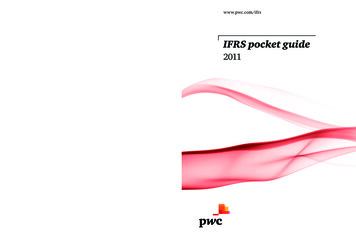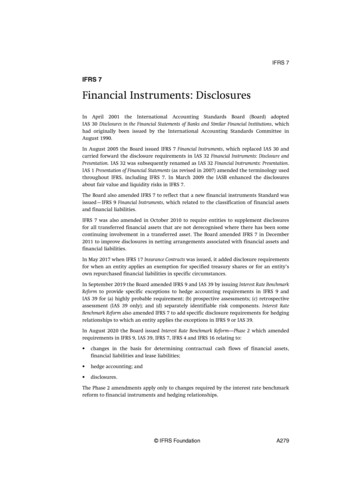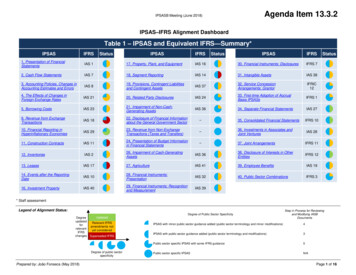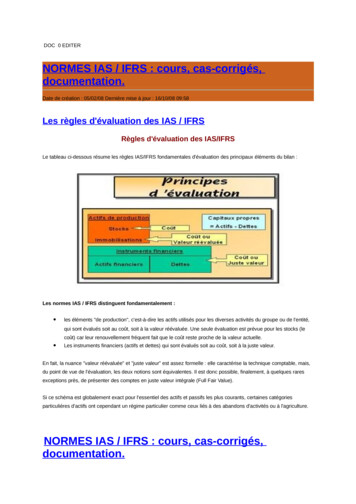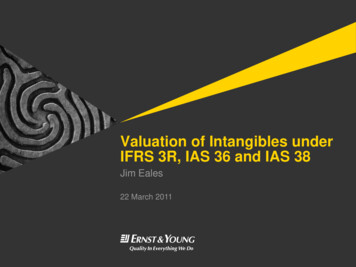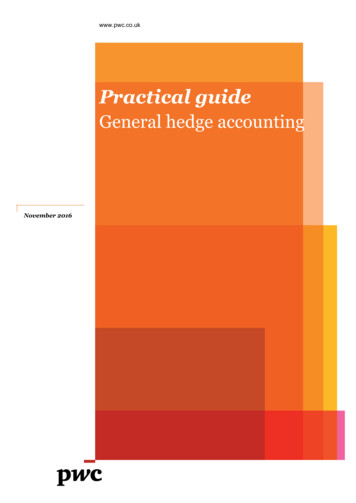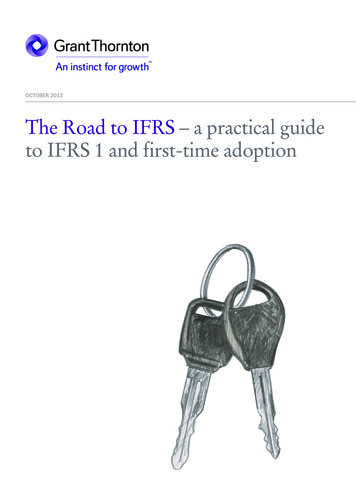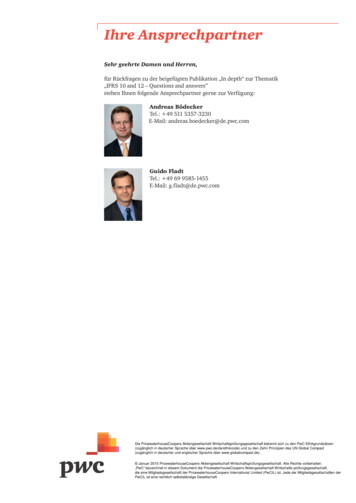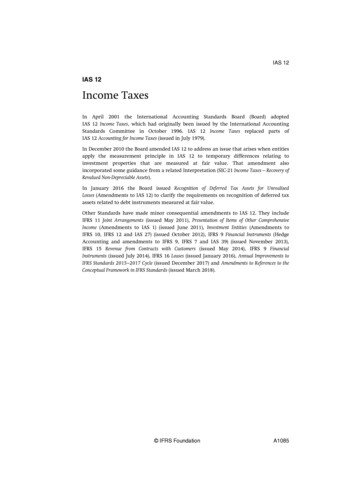
Transcription
IAS 12IAS 12Income TaxesIn April 2001 the International Accounting Standards Board (Board) adoptedIAS 12 Income Taxes, which had originally been issued by the International AccountingStandards Committee in October 1996. IAS 12 Income Taxes replaced parts ofIAS 12 Accounting for Income Taxes (issued in July 1979).In December 2010 the Board amended IAS 12 to address an issue that arises when entitiesapply the measurement principle in IAS 12 to temporary differences relating toinvestment properties that are measured at fair value. That amendment alsoincorporated some guidance from a related Interpretation (SIC-21 Income Taxes—Recovery ofRevalued Non-Depreciable Assets).In January 2016 the Board issued Recognition of Deferred Tax Assets for UnrealisedLosses (Amendments to IAS 12) to clarify the requirements on recognition of deferred taxassets related to debt instruments measured at fair value.Other Standards have made minor consequential amendments to IAS 12. They includeIFRS 11 Joint Arrangements (issued May 2011), Presentation of Items of Other ComprehensiveIncome (Amendments to IAS 1) (issued June 2011), Investment Entities (Amendments toIFRS 10, IFRS 12 and IAS 27) (issued October 2012), IFRS 9 Financial Instruments (HedgeAccounting and amendments to IFRS 9, IFRS 7 and IAS 39) (issued November 2013),IFRS 15 Revenue from Contracts with Customers (issued May 2014), IFRS 9 FinancialInstruments (issued July 2014), IFRS 16 Leases (issued January 2016), Annual Improvements toIFRS Standards 2015–2017 Cycle (issued December 2017) and Amendments to References to theConceptual Framework in IFRS Standards (issued March 2018). IFRS FoundationA1085
IAS 12CONTENTSfrom paragraphINTERNATIONAL ACCOUNTING STANDARD 12INCOME TAXESOBJECTIVESCOPE1DEFINITIONS5Tax base7RECOGNITION OF CURRENT TAX LIABILITIES AND CURRENT TAXASSETS12RECOGNITION OF DEFERRED TAX LIABILITIES AND DEFERRED TAXASSETS15Taxable temporary differences15Deductible temporary differences24Unused tax losses and unused tax credits34Reassessment of unrecognised deferred tax assets37Investments in subsidiaries, branches and associates and interests in jointarrangements38MEASUREMENT46RECOGNITION OF CURRENT AND DEFERRED TAX57Items recognised in profit or loss58Items recognised outside profit or lossDeferred tax arising from a business combinationCurrent and deferred tax arising from share-based payment transactions61A6668APRESENTATION71Tax assets and tax liabilities71Tax expense77DISCLOSURE79EFFECTIVE DATE89WITHDRAWAL OF SIC-2199APPROVAL BY THE BOARD OF DEFERRED TAX: RECOVERY OFUNDERLYING ASSETS (AMENDMENTS TO IAS 12) ISSUED IN DECEMBER2010APPROVAL BY THE BOARD OF RECOGNITION OF DEFERRED TAXASSETS FOR UNREALISED LOSSES (AMENDMENTS TO IAS 12) ISSUED INJANUARY 2016FOR THE ACCOMPANYING GUIDANCE LISTED BELOW, SEE PART B OF THIS EDITIONILLUSTRATIVE EXAMPLESFOR THE BASIS FOR CONCLUSIONS, SEE PART C OF THIS EDITIONBASIS FOR CONCLUSIONSA1086 IFRS Foundation
IAS 12International Accounting Standard 12 Income Taxes (IAS 12) is set out in paragraphs1–99. All the paragraphs have equal authority but retain the IASC format of theStandard when it was adopted by the IASB. IAS 12 should be read in the context ofits objective and the Basis for Conclusions, the Preface to IFRS Standards andthe Conceptual Framework for Financial Reporting. IAS 8 Accounting Policies, Changes inAccounting Estimates and Errors provides a basis for selecting and applying accountingpolicies in the absence of explicit guidance. IFRS FoundationA1087
IAS 12International Accounting Standard 12Income TaxesObjectiveThe objective of this Standard is to prescribe the accounting treatment for income taxes.The principal issue in accounting for income taxes is how to account for the current andfuture tax consequences of:(a)the future recovery (settlement) of the carrying amount of assets (liabilities) thatare recognised in an entity’s statement of financial position; and(b)transactions and other events of the current period that are recognised in anentity’s financial statements.It is inherent in the recognition of an asset or liability that the reporting entity expects torecover or settle the carrying amount of that asset or liability. If it is probable thatrecovery or settlement of that carrying amount will make future tax payments larger(smaller) than they would be if such recovery or settlement were to have no taxconsequences, this Standard requires an entity to recognise a deferred tax liability(deferred tax asset), with certain limited exceptions.This Standard requires an entity to account for the tax consequences of transactions andother events in the same way that it accounts for the transactions and other eventsthemselves. Thus, for transactions and other events recognised in profit or loss, anyrelated tax effects are also recognised in profit or loss. For transactions and other eventsrecognised outside profit or loss (either in other comprehensive income or directly inequity), any related tax effects are also recognised outside profit or loss (either in othercomprehensive income or directly in equity, respectively). Similarly, the recognition ofdeferred tax assets and liabilities in a business combination affects the amount ofgoodwill arising in that business combination or the amount of the bargain purchasegain recognised.This Standard also deals with the recognition of deferred tax assets arising from unusedtax losses or unused tax credits, the presentation of income taxes in the financialstatements and the disclosure of information relating to income taxes.Scope1This Standard shall be applied in accounting for income taxes.2For the purposes of this Standard, income taxes include all domestic andforeign taxes which are based on taxable profits. Income taxes also includetaxes, such as withholding taxes, which are payable by a subsidiary, associateor joint arrangement on distributions to the reporting entity.3[Deleted]A1088 IFRS Foundation
IAS 124This Standard does not deal with the methods of accounting for governmentgrants (see IAS 20 Accounting for Government Grants and Disclosure of GovernmentAssistance) or investment tax credits. However, this Standard does deal with theaccounting for temporary differences that may arise from such grants orinvestment tax credits.Definitions5The following terms are used in this Standard with the meanings specified:Accounting profit is profit or loss for a period before deducting tax expense.Taxable profit (tax loss) is the profit (loss) for a period, determined inaccordance with the rules established by the taxation authorities, uponwhich income taxes are payable (recoverable).Tax expense (tax income) is the aggregate amount included in thedetermination of profit or loss for the period in respect of current tax anddeferred tax.Current tax is the amount of income taxes payable (recoverable) in respectof the taxable profit (tax loss) for a period.Deferred tax liabilities are the amounts of income taxes payable in futureperiods in respect of taxable temporary differences.Deferred tax assets are the amounts of income taxes recoverable in futureperiods in respect of:(a)deductible temporary differences;(b)the carryforward of unused tax losses; and(c)the carryforward of unused tax credits.Temporary differences are differences between the carrying amount of anasset or liability in the statement of financial position and its tax base.Temporary differences may be either:(a)taxable temporary differences, which are temporary differences thatwill result in taxable amounts in determining taxable profit (taxloss) of future periods when the carrying amount of the asset orliability is recovered or settled; or(b)deductible temporary differences, which are temporary differences thatwill result in amounts that are deductible in determining taxableprofit (tax loss) of future periods when the carrying amount of theasset or liability is recovered or settled.The tax base of an asset or liability is the amount attributed to that asset orliability for tax purposes.6Tax expense (tax income) comprises current tax expense (current tax income)and deferred tax expense (deferred tax income). IFRS FoundationA1089
IAS 12Tax base7The tax base of an asset is the amount that will be deductible for tax purposesagainst any taxable economic benefits that will flow to an entity when itrecovers the carrying amount of the asset. If those economic benefits will notbe taxable, the tax base of the asset is equal to its carrying amount.Examples1A machine cost 100. For tax purposes, depreciation of 30 has alreadybeen deducted in the current and prior periods and the remaining costwill be deductible in future periods, either as depreciation or through adeduction on disposal. Revenue generated by using the machine istaxable, any gain on disposal of the machine will be taxable and any losson disposal will be deductible for tax purposes. The tax base of the machineis 70.2Interest receivable has a carrying amount of 100. The related interestrevenue will be taxed on a cash basis. The tax base of the interest receivable isnil.3Trade receivables have a carrying amount of 100. The related revenuehas already been included in taxable profit (tax loss). The tax base of thetrade receivables is 100.4Dividends receivable from a subsidiary have a carrying amount of 100.The dividends are not taxable. In substance, the entire carrying amount of theasset is deductible against the economic benefits. Consequently, the tax base of thedividends receivable is 100.(a)5A loan receivable has a carrying amount of 100. The repayment of theloan will have no tax consequences. The tax base of the loan is 100.(a) Under this analysis, there is no taxable temporary difference. An alternativeanalysis is that the accrued dividends receivable have a tax base of nil and that atax rate of nil is applied to the resulting taxable temporary difference of 100.Under both analyses, there is no deferred tax liability.8The tax base of a liability is its carrying amount, less any amount that will bedeductible for tax purposes in respect of that liability in future periods. In thecase of revenue which is received in advance, the tax base of the resultingliability is its carrying amount, less any amount of the revenue that will notbe taxable in future periods.Examples1Current liabilities include accrued expenses with a carrying amount of100. The related expense will be deducted for tax purposes on a cashbasis. The tax base of the accrued expenses is nil.2Current liabilities include interest revenue received in advance, with acarrying amount of 100. The related interest revenue was taxed on acash basis. The tax base of the interest received in advance is nil.continued.A1090 IFRS Foundation
IAS 12.continuedExamples3Current liabilities include accrued expenses with a carrying amount of100. The related expense has already been deducted for tax purposes. Thetax base of the accrued expenses is 100.4Current liabilities include accrued fines and penalties with a carryingamount of 100. Fines and penalties are not deductible for tax purposes.The tax base of the accrued fines and penalties is 100.(a)5A loan payable has a carrying amount of 100. The repayment of the loanwill have no tax consequences. The tax base of the loan is 100.(a) Under this analysis, there is no deductible temporary difference. An alternativeanalysis is that the accrued fines and penalties payable have a tax base of nil andthat a tax rate of nil is applied to the resulting deductible temporary difference of100. Under both analyses, there is no deferred tax asset.9Some items have a tax base but are not recognised as assets and liabilities inthe statement of financial position. For example, research costs are recognisedas an expense in determining accounting profit in the period in which theyare incurred but may not be permitted as a deduction in determining taxableprofit (tax loss) until a later period. The difference between the tax base of theresearch costs, being the amount the taxation authorities will permit as adeduction in future periods, and the carrying amount of nil is a deductibletemporary difference that results in a deferred tax asset.10Where the tax base of an asset or liability is not immediately apparent, it ishelpful to consider the fundamental principle upon which this Standard isbased: that an entity shall, with certain limited exceptions, recognise adeferred tax liability (asset) whenever recovery or settlement of the carryingamount of an asset or liability would make future tax payments larger(smaller) than they would be if such recovery or settlement were to have notax consequences. Example C following paragraph 51A illustratescircumstances when it may be helpful to consider this fundamental principle,for example, when the tax base of an asset or liability depends on the expectedmanner of recovery or settlement.11In consolidated financial statements, temporary differences are determined bycomparing the carrying amounts of assets and liabilities in the consolidatedfinancial statements with the appropriate tax base. The tax base is determinedby reference to a consolidated tax return in those jurisdictions in which such areturn is filed. In other jurisdictions, the tax base is determined by referenceto the tax returns of each entity in the group.Recognition of current tax liabilities and current tax assets12Current tax for current and prior periods shall, to the extent unpaid, berecognised as a liability. If the amount already paid in respect of currentand prior periods exceeds the amount due for those periods, the excessshall be recognised as an asset. IFRS FoundationA1091
IAS 1213The benefit relating to a tax loss that can be carried back to recovercurrent tax of a previous period shall be recognised as an asset.14When a tax loss is used to recover current tax of a previous period, an entityrecognises the benefit as an asset in the period in which the tax loss occursbecause it is probable that the benefit will flow to the entity and the benefitcan be reliably measured.Recognition of deferred tax liabilities and deferred tax assetsTaxable temporary differences15A deferred tax liability shall be recognised for all taxable temporarydifferences, except to the extent that the deferred tax liability arises from:(a)the initial recognition of goodwill; or(b)the initial recognition of an asset or liability in a transaction which:(i)is not a business combination; and(ii)at the time of the transaction, affects neither accountingprofit nor taxable profit (tax loss).However, for taxable temporary differences associated with investments insubsidiaries, branches and associates, and interests in joint arrangements,a deferred tax liability shall be recognised in accordancewith paragraph 39.16A1092It is inherent in the recognition of an asset that its carrying amount will berecovered in the form of economic benefits that flow to the entity in futureperiods. When the carrying amount of the asset exceeds its tax base, theamount of taxable economic benefits will exceed the amount that will beallowed as a deduction for tax purposes. This difference is a taxable temporarydifference and the obligation to pay the resulting income taxes in futureperiods is a deferred tax liability. As the entity recovers the carrying amountof the asset, the taxable temporary difference will reverse and the entity willhave taxable profit. This makes it probable that economic benefits will flowfrom the entity in the form of tax payments. Therefore, this Standard requiresthe recognition of all deferred tax liabilities, except in certain circumstancesdescribed in paragraphs 15 and 39. IFRS Foundation
IAS 12ExampleAn asset which cost 150 has a carrying amount of 100. Cumulativedepreciation for tax purposes is 90 and the tax rate is 25%.The tax base of the asset is 60 (cost of 150 less cumulative tax depreciation of 90).To recover the carrying amount of 100, the entity must earn taxable income of 100, butwill only be able to deduct tax depreciation of 60. Consequently, the entity will payincome taxes of 10 (40 at 25%) when it recovers the carrying amount of the asset. Thedifference between the carrying amount of 100 and the tax base of 60 is a taxabletemporary difference of 40. Therefore, the entity recognises a deferred tax liability of 10(40 at 25%) representing the income taxes that it will pay when it recovers the carryingamount of the asset.1718Some temporary differences arise when income or expense is included inaccounting profit in one period but is included in taxable profit in a differentperiod. Such temporary differences are often described as timing differences.The following are examples of temporary differences of this kind which aretaxable temporary differences and which therefore result in deferred taxliabilities:(a)interest revenue is included in accounting profit on a time proportionbasis but may, in some jurisdictions, be included in taxable profitwhen cash is collected. The tax base of any receivable recognised in thestatement of financial position with respect to such revenues is nilbecause the revenues do not affect taxable profit until cash is collected;(b)depreciation used in determining taxable profit (tax loss) may differfrom that used in determining accounting profit. The temporarydifference is the difference between the carrying amount of the assetand its tax base which is the original cost of the asset less alldeductions in respect of that asset permitted by the taxationauthorities in determining taxable profit of the current and priorperiods. A taxable temporary difference arises, and results in adeferred tax liability, when tax depreciation is accelerated (if taxdepreciation is less rapid than accounting depreciation, a deductibletemporary difference arises, and results in a deferred tax asset); and(c)development costs may be capitalised and amortised over futureperiods in determining accounting profit but deducted in determiningtaxable profit in the period in which they are incurred. Suchdevelopment costs have a tax base of nil as they have already beendeducted from taxable profit. The temporary difference is thedifference between the carrying amount of the development costs andtheir tax base of nil.Temporary differences also arise when:(a)the identifiable assets acquired and liabilities assumed in a businesscombination are recognised at their fair values in accordance withIFRS 3 Business Combinations, but no equivalent adjustment is made fortax purposes (see paragraph 19); IFRS FoundationA1093
IAS 12(b)assets are revalued and no equivalent adjustment is made for taxpurposes (see paragraph 20);(c)goodwill arises in a business combination (see paragraph 21);(d)the tax base of an asset or liability on initial recognition differs fromits initial carrying amount, for example when an entity benefits fromnon-taxable government grants related to assets (see paragraphs 22 and33); or(e)the carrying amount of investments in subsidiaries, branches andassociates or interests in joint arrangements becomes different fromthe tax base of the investment or interest (see paragraphs 38–45).Business combinations19With limited exceptions, the identifiable assets acquired and liabilitiesassumed in a business combination are recognised at their fair values at theacquisition date. Temporary differences arise when the tax bases of theidentifiable assets acquired and liabilities assumed are not affected by thebusiness combination or are affected differently. For example, when thecarrying amount of an asset is increased to fair value but the tax base of theasset remains at cost to the previous owner, a taxable temporary differencearises which results in a deferred tax liability. The resulting deferred taxliability affects goodwill (see paragraph 66).Assets carried at fair value20A1094IFRSs permit or require certain assets to be carried at fair value or to berevalued (see, for example, IAS 16 Property, Plant and Equipment, IAS 38 IntangibleAssets, IAS 40 Investment Property, IFRS 9 Financial Instruments and IFRS 16 Leases).In some jurisdictions, the revaluation or other restatement of an asset to fairvalue affects taxable profit (tax loss) for the current period. As a result, the taxbase of the asset is adjusted and no temporary difference arises. In otherjurisdictions, the revaluation or restatement of an asset does not affect taxableprofit in the period of the revaluation or restatement and, consequently, thetax base of the asset is not adjusted. Nevertheless, the future recovery of thecarrying amount will result in a taxable flow of economic benefits to theentity and the amount that will be deductible for tax purposes will differ fromthe amount of those economic benefits. The difference between the carryingamount of a revalued asset and its tax base is a temporary difference and givesrise to a deferred tax liability or asset. This is true even if:(a)the entity does not intend to dispose of the asset. In such cases, therevalued carrying amount of the asset will be recovered through useand this will generate taxable income which exceeds the depreciationthat will be allowable for tax purposes in future periods; or(b)tax on capital gains is deferred if the proceeds of the disposal of theasset are invested in similar assets. In such cases, the tax willultimately become payable on sale or use of the similar assets. IFRS Foundation
IAS 12Goodwill21Goodwill arising in a business combination is measured as the excess of (a)over (b) below:(a)(b)the aggregate of:(i)the consideration transferred measured in accordance withIFRS 3, which generally requires acquisition-date fair value;(ii)the amount of any non-controlling interest in the acquireerecognised in accordance with IFRS 3; and(iii)in a business combination achieved in stages, theacquisition-date fair value of the acquirer’s previously heldequity interest in the acquiree.the net of the acquisition-date amounts of the identifiable assetsacquired and liabilities assumed measured in accordance with IFRS 3.Many taxation authorities do not allow reductions in the carrying amount ofgoodwill as a deductible expense in determining taxable profit. Moreover, insuch jurisdictions, the cost of goodwill is often not deductible when asubsidiary disposes of its underlying business. In such jurisdictions, goodwillhas a tax base of nil. Any difference between the carrying amount of goodwilland its tax base of nil is a taxable temporary difference. However, thisStandard does not permit the recognition of the resulting deferred tax liabilitybecause goodwill is measured as a residual and the recognition of the deferredtax liability would increase the carrying amount of goodwill.21ASubsequent reductions in a deferred tax liability that is unrecognised becauseit arises from the initial recognition of goodwill are also regarded as arisingfrom the initial recognition of goodwill and are therefore not recognisedunder paragraph 15(a). For example, if in a business combination an entityrecognises goodwill of CU100 that has a tax base of nil, paragraph 15(a)prohibits the entity from recognising the resulting deferred tax liability. If theentity subsequently recognises an impairment loss of CU20 for that goodwill,the amount of the taxable temporary difference relating to the goodwill isreduced from CU100 to CU80, with a resulting decrease in the value of theunrecognised deferred tax liability. That decrease in the value of theunrecognised deferred tax liability is also regarded as relating to the initialrecognition of the goodwill and is therefore prohibited from being recognisedunder paragraph 15(a).21BDeferred tax liabilities for taxable temporary differences relating to goodwillare, however, recognised to the extent they do not arise from the initialrecognition of goodwill. For example, if in a business combination an entityrecognises goodwill of CU100 that is deductible for tax purposes at a rate of20 per cent per year starting in the year of acquisition, the tax base of thegoodwill is CU100 on initial recognition and CU80 at the end of the year ofacquisition. If the carrying amount of goodwill at the end of the year ofacquisition remains unchanged at CU100, a taxable temporary difference ofCU20 arises at the end of that year. Because that taxable temporary difference IFRS FoundationA1095
IAS 12does not relate to the initial recognition of the goodwill, the resulting deferredtax liability is recognised.Initial recognition of an asset or liability22A temporary difference may arise on initial recognition of an asset or liability,for example if part or all of the cost of an asset will not be deductible for taxpurposes. The method of accounting for such a temporary difference dependson the nature of the transaction that led to the initial recognition of the assetor liability:(a)in a business combination, an entity recognises any deferred taxliability or asset and this affects the amount of goodwill or bargainpurchase gain it recognises (see paragraph 19);(b)if the transaction affects either accounting profit or taxable profit, anentity recognises any deferred tax liability or asset and recognises theresulting deferred tax expense or income in profit or loss (seeparagraph 59);(c)if the transaction is not a business combination, and affects neitheraccounting profit nor taxable profit, an entity would, in the absence ofthe exemption provided by paragraphs 15 and 24, recognise theresulting deferred tax liability or asset and adjust the carrying amountof the asset or liability by the same amount. Such adjustments wouldmake the financial statements less transparent. Therefore, thisStandard does not permit an entity to recognise the resulting deferredtax liability or asset, either on initial recognition or subsequently (seeexample below). Furthermore, an entity does not recognise subsequentchanges in the unrecognised deferred tax liability or asset as the assetis depreciated.Example illustrating paragraph 22(c)An entity intends to use an asset which cost 1,000 throughout its useful lifeof five years and then dispose of it for a residual value of nil. The tax rate is40%. Depreciation of the asset is not deductible for tax purposes.On disposal, any capital gain would not be taxable and any capital loss wouldnot be deductible.As it recovers the carrying amount of the asset, the entity will earn taxable income of1,000 and pay tax of 400. The entity does not recognise the resulting deferred taxliability of 400 because it results from the initial recognition of the asset.In the following year, the carrying amount of the asset is 800. In earning taxableincome of 800, the entity will pay tax of 320. The entity does not recognise the deferredtax liability of 320 because it results from the initial recognition of the asset.23A1096In accordance with IAS 32 Financial Instruments: Presentation the issuer of acompound financial instrument (for example, a convertible bond) classifiesthe instrument’s liability component as a liability and the equity componentas equity. In some jurisdictions, the tax base of the liability component oninitial recognition is equal to the initial carrying amount of the sum of the IFRS Foundation
IAS 12liability and equity components. The resulting taxable temporary differencearises from the initial recognition of the equity component separately fromthe liability component. Therefore, the exception set out in paragraph 15(b)does not apply. Consequently, an entity recognises the resulting deferred taxliability. In accordance with paragraph 61A, the deferred tax is chargeddirectly to the carrying amount of the equity component. In accordance withparagraph 58, subsequent changes in the deferred tax liability are recognisedin profit or loss as deferred tax expense (income).Deductible temporary differences24A deferred tax asset shall be recognised for all deductible temporarydifferences to the extent that it is probable that taxable profit will beavailable against which the deductible temporary difference can beutilised, unless the deferred tax asset arises from the initial recognition ofan asset or liability in a transaction that:(a)is not a business combination; and(b)at the time of the transaction, affects neither accounting profit nortaxable profit (tax loss).However, for deductible temporary differences associated with investmentsin subsidiaries, branches and associates, and interests in jointarrangements, a deferred tax asset shall be recognised in accordance withparagraph 44.25It is inherent in the recognition of a liability that the carrying amount will besettled in future periods through an outflow from the entity of resourcesembodying economic benefits. When resources flow from the entity, part orall of their amounts may be deductible in determining taxable profit of aperiod later than the period in which the liability is recognised. In such cases,a temporary difference exists between the carrying amount of the liability andits tax base. Accordingly, a deferred tax asset arises in respect of the incometaxes that will be recoverable in the future periods when that part of theliability is allowed as a deduction in determining taxable profit. Similarly, ifthe carrying amount of an asset is less than its tax base, the difference givesrise to a deferred tax asset in respect of the income taxes that will berecoverable in future periods. IFRS FoundationA1097
IAS 12ExampleAn entity recognises a liability of 100 for accrued product warranty costs.For tax purposes, the product warranty costs will not be deductible until theentity pays claims. The tax rate is 25%.The tax base of the liability is nil (carrying amount of 100, less the amount that will bedeductible for tax purposes in respect of that liability in future periods). In settling theliability for its carrying amount, the entity will reduce its future taxable profit by anamount of 100 and,
IAS 12 Income Taxes In April 2001 the International Accounting Standards Board (Board) adopted IAS 12 Income Taxes, which had originally been issued by the International Accounting Standards Committee in October 1996. IAS 12 Income Taxes replaced parts of IAS 12 Accounting for Income Taxes (issued in July 1979). In December 2010 the Board amended IAS 12 to address an issue that arises when .
